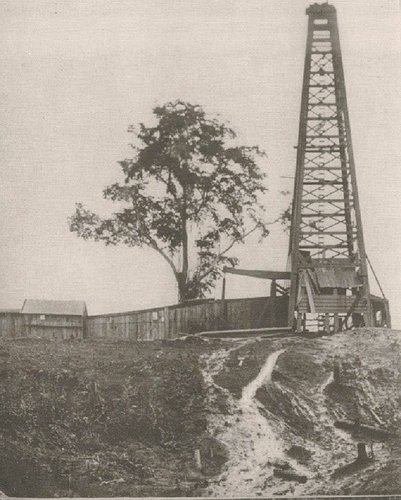Postby TriP » March 24th, 2016, 1:41 am
Local Oil Industry - 1
In Trinidad first attempts to drill for oil had been made in 1857. The American Merrimac Oil Company struck oil at La Brea in 1857 at a depth of 280 feet but two years later the well was closed down. It had not yielded enough to make the venture viable for Merrimac.
Around the same time, the first really successful oil well in the world was drilled in Pennsylvania in the USA which saw essential technological breakthroughs.
Walter Darwent was the next oil pioneer who arrived where he established the Paria Petroleum Company in 1865.While his contemporary Conrad Stollmeyer, was still convinced that asphalt from the Pitch Lake was the best raw material for the distillation of fuel, and distilled 2 - 3 barrels of oil per day from the asphalt with his Trinidad Petroleum Company, but Darwent maintained that oil drilled from the ground would be.
In 1867, Darwent’s Paria Petroleum struck oil with three wells at Aripero and San Fernando, and soon produced up to 60 gallons of crude oil a week. Several other wells around the Pitch Lake gave a little more, and the company was able to export some oil to the USA and Great Britain but yielded to the same fate as Merrimac: not enough yield, not enough demand, not enough profit.
For the rest of the century, there was no oil industry in Trinidad and Stollmeyer and Darwent experimented for a while with making combustible fuel from the pitch of the Pitch Lake. The resulting fuel proved quite successful in tests with steamers and a saw mill.
In 1868, Darwent succumbed to yellow fever at the age of 47 years, and dreams of drilling in Trinidad were buried with him for almost 50 years. Important incentives for the search for oil came from Germany: in 1876, Nikolaus Otto invented the four-stroke engine, and ten years later, when Carl Friedrich Benz developed the first automobile.
In 1883, Gottlieb Daimler completed the first fast-running combustion engine, and two years later he built the first motorcycle. Rudolf Diesel invented his powerful heavy oil engine in 1893, and finally Henry Ford who built the first automobile factory in 1903. Within two decades, demand for combustible fuel, and oil industries all over the world started to soar.
In Trinidad, engineer Randolph Rust and businessman John Lee Lum joined forces. They tried to get financial backing for oil exploration in south-east Trinidad.
After five years they finally succeeded, when the Canadian Walkerville Whisky Company formed the Oil Exploration Syndicate of Canada.
In 1902, Rust and Lee Lum struck oil several miles up the Pilote River in the thick forest at a depth of 850 feet. “It was brought up in a primitive fashion,” writes Anthony de Verteuil in his book ‘Eight East Indian Immigrants’, quoting a newspaper account. “From an immense iron-frame scaffolding, there hung by a steel wire a peculiar dipper in the shape of a long steel tube, stopped at the lower end with a valve, which, on being let down into the well, fills with oil, and then returning full of oil, is diverted into a barrel nearby.”
Finally - oil in larger quantities, between 75 and 100 barrels per day! However funding ran out and in 1907 Rust and Lee Lum as oil pioneers became history.
Thereafter, a British petroleum consultant called Arthur Beeby Thompson prospected oil near La Brea and Guapo. His company, Trinidad Oilfields Limited, was launched on the London stock market in 1910, then drilled very successful wells, and in 1911, construction of the first refinery in Trinidad began. For south Trinidad, the budding oil fields also meant an improvement in the infrastructure.
“Every well drilled on the company’s holdings in 1910-11 proved a producer, and the whole operation was modernised, supply, tankage, an extension to the railway, more roadways, and an extension to the jetty.” Employment spiked: unskilled labourers averaged 74 cents a day, which was better than nothing at all! But working conditions in the swampy south were not rosy: swarms of mosquitoes and a scarce water supply in the dry season didn’t make the hard drilling work in the hot sun any easier. Malaria was dreaded, and at the end of 1913, 150 cases of yellow fever were reported, and three drillers died.
1910 - 1920 were veritable boom years in the oil industry: no less than 57 oil companies were formed between 1909 and 1912! Overseas, the car industry started to pick up, and when British home secretary Winston Churchill announced the decision to change the Royal Navy from burning coal to burning fuel in 1910, the ‘oil rush’ officially commenced in Trinidad.
On the eve of World War I in 1914, Trinidad’s annual oil production had risen to 1 million barrels. 80 companies had been registered - but of course not all were successful
-
Attachments
-




